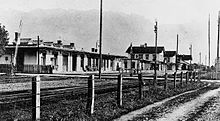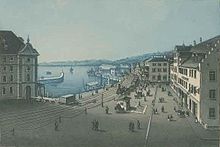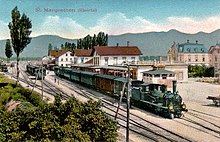United Swiss Railways
| United Swiss Railways (VSB) | ||||||||||||||||||||||||||||||||||||||||||||||||||||||||||||||||||||||||||||||||||||||||||||||||||||
|---|---|---|---|---|---|---|---|---|---|---|---|---|---|---|---|---|---|---|---|---|---|---|---|---|---|---|---|---|---|---|---|---|---|---|---|---|---|---|---|---|---|---|---|---|---|---|---|---|---|---|---|---|---|---|---|---|---|---|---|---|---|---|---|---|---|---|---|---|---|---|---|---|---|---|---|---|---|---|---|---|---|---|---|---|---|---|---|---|---|---|---|---|---|---|---|---|---|---|---|---|
| Gauge : | 1435 mm ( standard gauge ) | |||||||||||||||||||||||||||||||||||||||||||||||||||||||||||||||||||||||||||||||||||||||||||||||||||
|
||||||||||||||||||||||||||||||||||||||||||||||||||||||||||||||||||||||||||||||||||||||||||||||||||||
The United Swiss Railways (VSB or VSB) were a railway company of Switzerland . They were the smallest of the five main railways that were nationalized from 1902 .
Foundation and financing
The United Swiss Railways came into being on May 1, 1857 through the merger of three railway companies, all of which were in financial difficulties:
- The St. Gallisch-Appenzell Railway (SGAE) put the Winterthur - Wil - St. Gallen - Rorschach line into operation between October 15, 1855 and October 25, 1856 . A number of significant bridges had to be built during the construction of the railway line. There was a lack of funds for the final payments for the ongoing construction work.
- The Südostbahn (SOB) - not to be confused with today's Swiss Südostbahn - sought to build a Lukmanier ground, which by the engineer as early as 1839 Richard La Nicca had been suggested. The company was founded on September 1, 1853 with share capital of 25 million francs. The capital came from the cantons of St. Gallen and Graubünden and above all from English banks. The start of the construction work carried out by English contractors was unsatisfactory. The chief engineer Pickering was dismissed without notice. Due to financial difficulties, the construction of the Rorschach - St. Margrethen - Sargans - Chur , Sargans - Weesen - Ziegelbrücke - Rapperswil and Weesen - Glarus routes stalled. The section on the Walensee required the construction of many tunnels. The lines of the Südostbahn would have become lucrative access lines if an Eastern Alpine Railway had come about.
- The Glatthalbahn (Gl-TB) opened the Wallisellen - Uster line on August 1, 1856 . However, there was not enough money to continue building the line to Rapperswil.
The VSB's financial start-up problems resulted, among other things, from the fact that the construction costs were estimated far too low, which led to an additional requirement for capital of around 20 million francs. A French investor was found to provide capital. The Parisian banker Isaac Pereire from Crédit mobilier aimed for a transversal to the Eastern Alps as a link between the French railway companies Chemin de fer du Midi , Chemins de fer de l'Ouest and Chemin de fer de l'Est with its rail holdings in the Balkans .
Further development
The VSB supported projects for a Splügen railway up until the 1890s , but they had no chance due to a lack of funding. At least the VSB managed to enforce a right of joint use on the Wallisellen – Zurich line of the Swiss Northeast Railway (NOB) for the important connection to Zurich .
Since the construction of an Eastern Alpine Railway from Chur to Italy opposite the Gotthard Railway was subject, the Rhine Valley Railway from Rorschach to Chur remained a regional line. Over time, Rorschach was ousted by Romanshorn as the leading port city on the Swiss shores of Lake Constance . The NOB expanded the port in Romanshorn and put its own steamships into operation. In 1869 the NOB opened the Rorschach – Romanshorn lake line , with the NOB track lying next to that of the VSB between Rorschach Hafen and Rorschach. The sea line of the NOB and the Bischofszellerbahn Gossau - Sulgen , which went into operation in 1876 , withdrew some traffic from the VSB. Since the NOB began operating on the shorter, left-bank Zurich- Thalwil- Brick Bridge in 1875 , the former main line Wallisellen-Rapperswil lost its importance. The VSB were able to hold their own thanks to extreme frugality. In the Rorschach workshop, under the direction of Adolf Klose, machine-technical achievements and locomotive designs were created, which received attention and recognition.
In connection with the merger negotiations, the VSB was able to take over the concession for the construction of a Bötzbergbahn on July 16, 1857 . In 1864 the VSB gave up this concession due to a lack of financial means.
The VSB took care of the operation of some other companies, such as the Toggenburgerbahn (TB), which opened in 1870 , the Wald – Rüti-Bahn (WR) opened in 1876 and, for a time, the Lake Zurich – Gotthardbahn (ZGB). The VSB was also financially involved in the Toggenburg and Wald – Rüti railway.
Until the 1870s, the VSB suffered from a lack of international connections. The competitor of the VSB, the Swiss Nordostbahn (NOB), the conveyed goods wagons with Trajektschiffen across lake . The United Swiss Railways pushed the construction of a Bodenseegürtelbahn (sections St. Margrethen – Lauterach and Lauterach – Lindau ). In 1865 this strategy, which is important for the canton of St. Gallen, was secured by an international treaty . On August 1, 1872, the Vorarlberger Bahn (VB) handed over the connection from St. Margrethen to Lindau and on October 20, 1872 also the Feldkirch – Buchs railway line , which stimulated traffic. The Arlbergbahn , which opened on September 6, 1884, had a significant impact on traffic development . With the opening of the narrow-gauge Landquart – Davos railway in 1889 and the Rhaetian Railway's Chur – Thusis line in 1896 , the VSB became their access line.
Like many other societies, the VSB suffered badly from the economic crisis at the end of the 1870s. Their share prices fell massively. In contrast to the NOB or the Swiss Central Railway , the VSB were able to distribute a modest dividend from 1871 onwards. Because the VSB was not allowed to expand the network further after 1859, the financial base was very solid with a low level of debt.
During the railway accident in Vonwil on December 31, 1879 , a train coming from Winterthur derailed in Vonwil near St. Gallen . The two locomotives came to rest to the left and right of the railroad track, the cars pushed into one another. The accident claimed two lives and several, some seriously injured.
Route network
| No. | Designation of the individual lines | opening | comment | Property length | Operating length |
|---|---|---|---|---|---|
| 1. | Winterthur – St. Gallen | September 28, 1855 - March 25, 1856 | built by SGAE | 71,889 km | 72,765 km |
| St. Gallen – Rorschach | October 25, 1856 | ||||
| 2. | Rorschach Harbor – Rorschach | 92,349 km | 91,730 km | ||
| Rorschach – St. Margrethen – Sargans – Chur | August 25, 1857 - July 1, 1858 | projected by SOB | |||
| 3. | Sargans – Weesen – Ziegelbrücke | February 15, 1859 - July 1, 1859 | 93,048 km | 102,194 km | |
| Brick Bridge – Rapperswil | February 15, 1859 | ||||
| Rapperswil – Uster – Wallisellen (–Zurich) | August 1, 1856 - February 15, 1859 | built by Gl-TB and VSB | |||
| 4th | Weesen – Näfels – Glarus | February 15, 1859 | Projected by SOB Weesen– Näfels. 1918 Operation ceased, 1931 canceled |
11,638 km | 11,488 km |
| 5. | Toggenburgerbahn (TB): Wil – Ebnat-Kappel | June 24, 1870 | 24,852 km | ||
| 6th | Wald-Rüti Railway (WR): Wald – Rüti ZH | September 29, 1876 | 6,570 km | ||
| 7th |
Lake Zurich – Gotthard Railway (ZGB): Rapperswil – Pfäffikon SZ |
August 27, 1878 (until December 31, 1889) |
1890 merger with WE | 4,020 km | |
| Total | 268,924 km | 313,619 km |
Rolling stock
The locomotives that were procured by the VSB or its predecessor railways reached an average age of 38.7 years.If you omit the eight machines from the Glatthalbahn, which were sold to Italy after 5 to 7 years, you even get an average age of 93 other machines from 41.6 years. The last VSB steam locomotive was retired from the SBB in 1933.
The series designation of the VSB locomotives was from 1860 to 1886 with Roman numerals I to VI according to the chronological order of the series. From 1887 onwards, the locomotives were named according to the system that was standardized throughout Switzerland .
The fleet included the following machine types. The designation valid from 1902 is shown in brackets.
| Series until 1887 |
Series from 1887 |
CDB no. until 1902 |
SBB no. from 1902 |
number | Construction year | Manufacturer | Wheel alignment | discarded | comment | image |
|---|---|---|---|---|---|---|---|---|---|---|
| I. | - ( Ec 2/5 ) | 1-12 | - | 12 | 1855-56 | Esslingen | B3 ' | (1874–1886 converted into Series III) |
Engerth type , taken over by SGAE in 1857 |
|
| 12-20 | 8th | 1858-59 | Escher Wyss | Engerth type, ordered by SOB | ||||||
| II | A2E ( Eb 2/5 ) | 21-22 | - | 20th | 1857-58 | Esslingen | B3 ' | 1881 | Engerth type, ordered by SOB |

|
| 23-32 | 5680-5699 | 1902-1925 | ||||||||
| 32-40 | Engerth type | |||||||||
| 21'-22 ' | 2 | 1895 | VSB Rorschach | 1909 | Construction type Engerth , parts from No. 21-22 reused | |||||
| II | B2T ( C 2/2 ) | 41'-42 ' from 1880: 91-92 |
91-92 | 2 | 1875 | Krauss | B. | 1903 |

|
|
| II | B2T ( B 2/3 ) | 45'-46 ' | 1071-1072 | 2 | 1876 | VSB | 1'B | 1904-1905 |
|
|
| III | - ( C 2/3 ) | 41-43 | - | 8th | 1856-57 | Karlsruhe | 1'B | Sold to Italy in 1863 |
Taken over by Glatthalbahn in 1857 , where it was designated as Series V. | |
| 44-48 | 1858 | ordered by Gl-TB | ||||||||
| III | B3 ( C 3/3 ) | 1-20 | 2451-2470 | 20th | 1874–1886 rebuilt from series I. | C. | 1903-1931 |
|
||
| IV | D4 ( Ed 4/4 ) | 61-64 | 7591-7594 | 4th | 1876-77 | Hartmann | D. | 1908-1925 |

|
|
|
from 1885: V from 1886: III |
E3 ( E 3/3 ) | TB 1-3 | 8395-8397 | 3 | 1870 | Krauss | C. | 1909-1912 | procured by the VSB for the operation of the Toggenburgerbahn |

|
| VI | E2 ( Ec 2/2 ) | 71-87 | 6071-6087 | 17th | 1875-1902 | VSB, Hartmann, Esslingen, SLM | B3 | 1911-1933 | No. 86–87 delivered to SBB |

|
| (no) | F2 ( E 2/2 ) | A, B, C | 8197-8199 | 3 | 1876 | Krauss | B. | 1902 (1948) |

|
|
| - | A3T ( B 3/4 ) | 101-115 | 1581-1595 | 15th | 1890-1901 | SLM | 1'C | 1913-1929 | Superheated steam - two-cylinder composite locomotive |
|
| - | B3T ( C 3/3 ) | 151-157 | 2481-2487 | 7th | 1892, 97 | Hartmann, SLM | C. | 1915-1924 |
|
|
business




Because of rising wood prices, the VSB searched for alternatives for firing their steam locomotives and 1,857 large is secured peat occur in Möggingen in Radolfzell . As a means of mass transport, the railroad enabled access to foreign hard coal deposits. In 1861, the VSB had largely completed the conversion to coal-firing.
In 1865 the VSB violated the telegraph shelf with the recently introduced electrical signal discs . In 1872 wagons and locomotives were converted to the buffer system.
From July 18 to 27, 1874, the Federal Shooting Festival took place in St. Gallen . The VSB transported 140,000 people to St. Gallen within ten days, which was only possible with the support of staff and rolling stock from the NOB and VB.
On December 31, 1879, a train coming from Winterthur derailed at Vonwilbrücke near St. Gallen. The two locomotives came to rest to the left and right of the railroad track, the cars pushed into one another. The accident claimed two lives and several, some seriously injured.
→ Main article: Railway accident in Vonwil
The national exhibition in Zurich in 1883 brought the first continuous train from Rorschach via St. Gallen to Zurich. Before that, the VSB trains had to be switched to the NOB trains in Winterthur. On June 1, 1894, the Bernese time was replaced by Central European Time (CET). Since June 1, 1896, direct cars have been running between St. Gallen and Geneva .
nationalization

In 1901, shortly before the nationalization , the VSB took over the Toggenburgerbahn (TB) without compensation from the canton of St. Gallen , which indirectly subsidized the construction of the Ricken tunnel. On July 1, 1902, the VSB was nationalized and from then on belonged to the Swiss Federal Railways (SBB). The VSB started operating on January 1, 1901, for the account of the federal government.
Part of the old company structures was retained for a long time. The former SBB District Directorate IV emerged from the VSB headquarters in St. Gallen. The former SBB main workshop in Chur had its roots in the SOB. Over time, the now closed SBB Rorschach locomotive depot emerged from the VSB's main workshop . The oldest ring segment locomotive depot with a turntable in Switzerland still exists in Uster from the time of the VSB . The carriage house has been restored and now serves as a depot and locomotive workshop of the Steam Railway Club Zurich Oberland , the heritage railway line Bauma - Hinwil operates.
With the electrification of the replacement was 1925-1928 Sitter , Glatt - Uze - and Thur bridge between St. Gallen and Wil and the wooden Rhine bridge at Ragaz due. The stone bridge over the Goldach , however, was preserved and has been used in two lanes since 1993 .
The kilometering of the lines of the former VSB was not changed . The kilometer indications still begin in Sargans, where kilometer 0 is located.
literature
- Hans Wegmann: The United Swiss Railways. Dissertation Zurich 1917.
- Placid Weissenbach : The railway system in Switzerland. (PDF 14.8 MB) First part. History of the Railway System. 1913, accessed February 1, 2014 .
- Hans-Peter Bärtschi : United Swiss Railways (VSB). In: Historical Lexicon of Switzerland . February 25, 2013 , accessed February 1, 2014 .
- United Swiss Railways. In: bahndaten.ch. Data on the Swiss railways 1847–1920. Thomas Frey and Hans-Ulrich Schiedt, ViaStoria, accessed on February 1, 2014 .
- Anton Heer: Rorschach-St.Gallen-Winterthur: between 170 years of railway history and the future. (PDF 14.2 MB) Historical Association of the Canton of St.Gallen, 2005, accessed on February 1, 2014 .
- Dietler: United Swiss Railways. In: Röll: Encyclopedia of the Railway System. 1923, accessed February 1, 2014 .
- 150 years of the Rhine Valley Line. (PDF 3.1 MB) Anniversary magazine. Cantonal schools in Sargans and Heerbrugg, 2008, accessed on February 1, 2014 .
- Hans G. Wägli: Swiss rail network and Swiss rail profile CH + . AS Verlag, Zurich 2010, ISBN 978-3-909111-74-9 .
Web links
- The Confederation. Shooting festival in St. Gallen. (PDF 2.5 MB) Die Eisenbahn = Le chemin de fer, Volume 3 (1875), Issue 4, pp. 32–33 , accessed on February 1, 2014 .
- The federal rifle festival in St. Gallen and the St. Gallen train station. (PDF 2.5 MB) Die Eisenbahn = Le chemin de fer, Volume 3 (1875), Issue 11, pp. 97-98 , accessed on February 1, 2014 .
Individual evidence
- ^ Anton Heer: 150 years of the Rorschach-Konstanz lake line: How the lake railway started rolling. In: St. Galler Tagblatt (online) from May 1, 2019
- ^ The railway accident in Vonwil near St. Gallen on December 31, 1879. (PDF 1.6 MB) Die Eisenbahn = Le chemin de fer, Volume 12 (1880), Issue 3, pp. 16-17 , accessed on February 1, 2014 .
- ^ The SBB numbered the locomotives they took over after the boiler overhauls were due.
- ↑ Incorrectly referred to as a tank locomotive by the VSB .
- ↑ After the conversion at the VSB, still incorrectly referred to as a tank locomotive.







